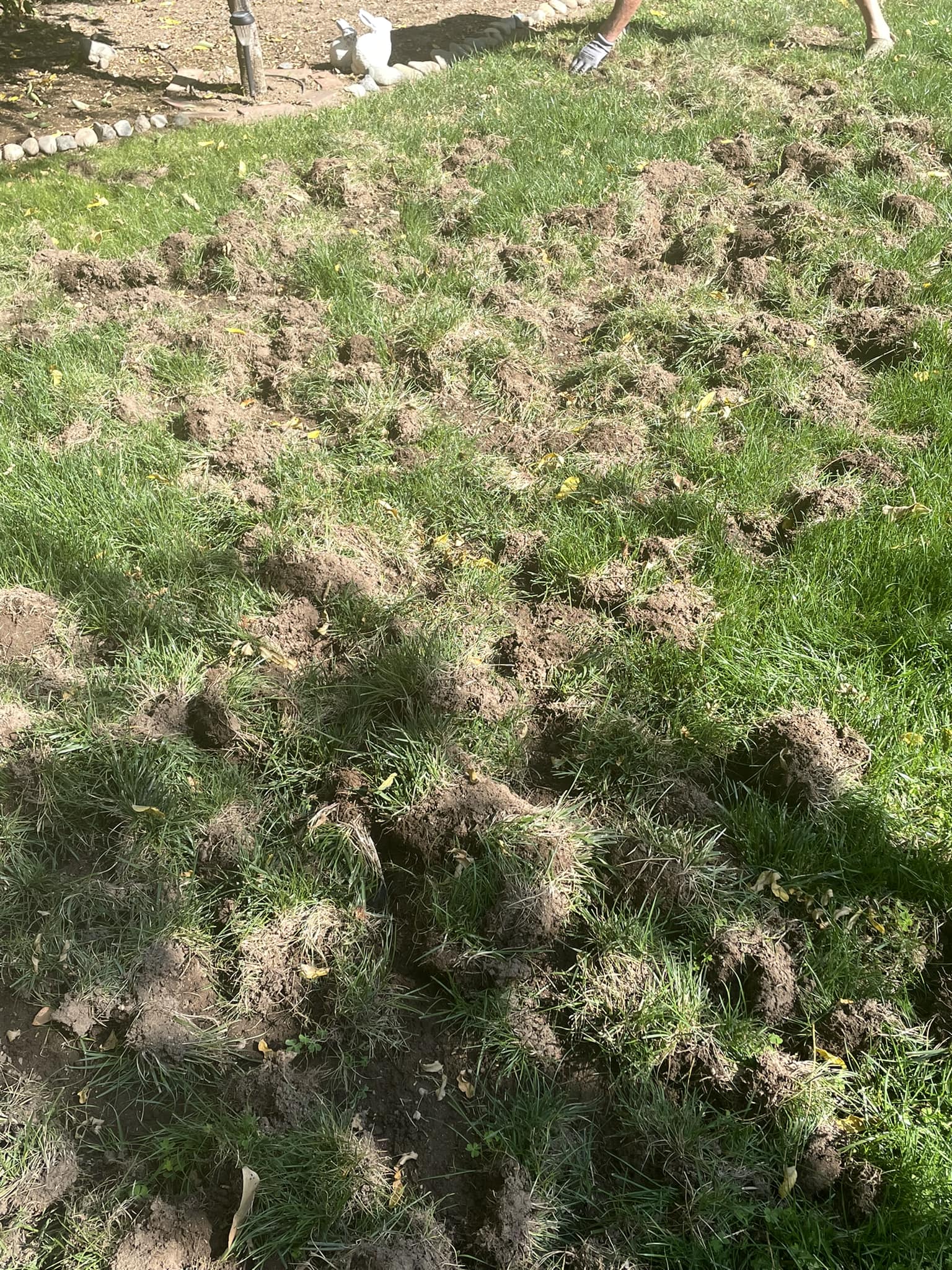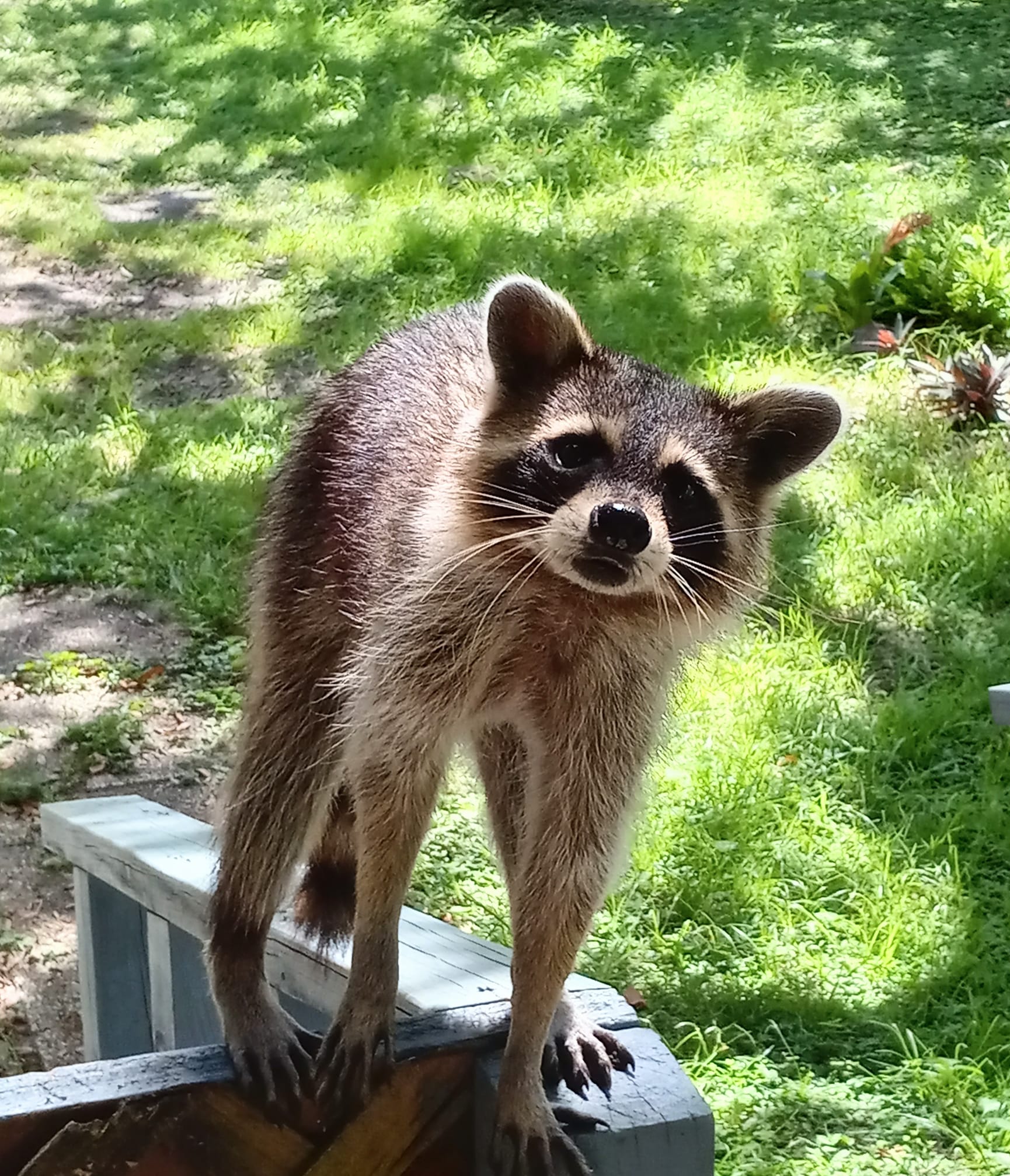When darkness comes, and you take a well-deserved sleep, a cute, clever, yet menacing small mammal with a knack for havoc comes out to play. Raccoons love rummaging through trash foraging for food, and while they don’t create tunnels, they dig shallow holes.
Should raccoons invade your yard, getting rid of them can turn into a persistent challenge. However, fear not! You can bid these furry troublemakers goodbye and reclaim your outdoor sanctuary with a few strategies and a dash of know-how.
Join me in uncovering the strategies for getting rid of raccoons in your yard. Your journey begins with recognizing the signs of a raccoon invasion.
Signs You Have a Raccoon Problem in Your Yard
You don’t have to see the raccoons with your eyes to know that they are in your yard. After all, they are nocturnal. So, if you see these things, chances are you have a raccoon issue.
a) Knocked Over Trash Cans
Do you constantly find your trash cans tipped over and their contents scattered? If yes, it is likely the work of raccoons. They are notorious for rummaging through garbage because the food waste attracts them.
b) Tracks and Smudges
Another telltale sign of a raccoon invasion is tracks and smudges. You can easily see raccoon footprints in muddy areas or on softer ground. Look for paw prints with five toes and small hand-like prints.
Moreover, look for consistent tracks along pathways leading to or from your trash cans, garden, or any area they frequently visit since raccoons often follow specific routes.
Additionally, they might leave streaks or stains on surfaces like windows, walls, or even on trash cans.
Related Posts:
c) Torn or Damaged Garden
Raccoons habitually dig shallow holes or patches in lawns or garden beds in search of insects, grubs, or other food sources. Their digging can leave behind noticeable disturbances in the soil, so look for areas where the ground appears freshly turned over or disrupted.
Raccoons can also partially or completely uproot and eat the leaves or stems. They can target fruits, vegetables, or ornamental plants.
d) Fecal Matter
Raccoon feces are small to medium-sized cylinders with rounded or slightly tapered ends. They are often dark in color, usually brown or black, and may contain undigested food particles like seeds or berries.
They tend to defecate in specific areas like near their den sites, along paths they frequently travel, or close to food sources such as trash cans or feeding spots. It is common to find multiple raccoon droppings in one area.
e) Damage to Structures
Yes, raccoons can cause damage to structures like sheds, attics, or even parts of your house as they look for shelter or food. But what are the signs of raccoon-related damage to structures?
Raccoons can leave scratches or claw marks on wooden surfaces, walls, roofs, or other structures they climb on. They can also pry up or tear shingles or other roofing materials to gain entry to attics or other sheltered spaces.
You may also notice twigs, leaves, or other materials scattered near their entry points or in the vicinity of the damage. Also, watch out for gnawing or tearing through weak spots in structures, including vents, soffits, or fascia boards.
f) Unusual Noises at Night
Being nocturnal, raccoons do their activities at night, so if you hear unusual sounds like scratching, thumping, or rustling around your home during the night, it could indicate raccoons moving around.
You might hear the scratching sounds of raccoons, particularly in the late evening or early morning, as they climb or move across surfaces, such as walls, roofs, or attics. You may also hear audible thumping or walking noises.
In addition, they can chatter, growl, and hiss to communicate.
g) Pet Food Disappearing
If you leave pet food outside, raccoons might consume them, so if you notice that your pet’s food is disappearing quickly, it could be due to raccoons.
Moreover, look for signs of disturbance around the pet food area, such as scattered food or overturned bowls. You might also see raccoon tracks or smudges around the pet food area, mainly if the ground is soft or muddy.
h) Damaged Coops
Have you noticed your chickens, and especially their eggs, disappearing? This might be the work of raccoons. Raccoons can attempt to break into coops by damaging locks, hinges, or any weak spots in the structure, so you may see broken latches or damaged wire mesh.
Also, watch out for scratch marks or signs of attempted entry on coop doors, walls, or fencing.
How To Get Rid Of Raccoons in Your Yard
Raccoons’ determination and persistence make eliminating them quite challenging, but you can do it. Although there are lethal ways of dealing with raccoons, choose humane, safe methods.
1. Secure Trash Bins
The smell of the food waste in your trash cans is pretty irresistible to raccoons, and if they can easily access the contents, they will keep coming to your yard. So, how can you prevent this? Secure your bins with tight-fitting lids.
If possible, get bins with locking mechanisms or bungee cords. Alternatively, place heavy objects on top of the lids, such as a brick or a weight, to make it harder for raccoons to open them.
Also, consider keeping your trash cans indoors or in a garage until the morning of pickup. Moreover, rinse your trash cans regularly to remove any food residue or odors that might attract raccoons.
2. Remove Food Sources
Food is the primary reason you have a raccoon problem in the first place. Therefore, in order to eliminate this problem, you must make it hard for them to find food.
- Feed your pets indoors or pick up their food bowls after they’ve finished eating.
- Regularly clean up any fruits that drop in your yard, especially during the harvesting season.
- Clean up spilled seeds regularly, as they can attract raccoons and other animals.
- Use enclosed compost bins that are difficult for raccoons to access.
- If you have a barbecue or outdoor kitchen, clean them thoroughly after use to remove food odors and spills.
- If you store pet food, birdseed, or any other animal feed in your yard, keep it indoors in airtight containers or secure sheds.
3. Secure Your Property
Inspect your house, garage, sheds, and other structures for gaps, holes, or openings that raccoons could use to gain entry. After that, seal these openings with heavy-duty materials like wire mesh, plywood, or metal flashing.
Block access to your deck, porch, or foundation’s crawl spaces with hardware cloth or wire mesh. Raccoons can also get in through the openings or gaps in your attic, including vents and chimneys, so install mesh or covers over vents and cap chimneys.
Furthermore, trim tree branches that overhang your house or structures to prevent these skilled climbers from accessing rooftops or upper levels. Also, secure your property with sturdy fencing. Use materials like wire mesh or hardware cloth, and bury the fencing several inches underground to prevent raccoons from digging underneath.
4. Set Up Motion-Activated Lights or Sprinklers
You can use raccoons’ sensitivity to sudden bright lights to drive them away. Install motion-activated lights around your yard or near areas where raccoons frequent, aiming them at potential entry points or where raccoons tend to scavenge for food.
Also, raccoons dislike water, so consider setting up motion-activated sprinklers near trash cans, gardens, or areas where raccoons might frequent.
5. Live Traps
Live traps suited for raccoons are typically cage-like devices with a door that closes when triggered. Place them in areas where you have signs of raccoon activity and bait them with items raccoons find irresistible, such as marshmallows, cat food, or peanut butter.
So that you do not leave any captured raccoons inside for too long, check the trap frequently, preferably every few hours. Release them far from your property. Check local regulations or contact wildlife control authorities for guidance on where it’s safe and legal to release them.
6. Use Repellents
Encourage raccoons to find shelter elsewhere by making your home unpleasant with particular smells raccoons have aversions to. Here are some ideas.
- Commercial Repellents: There are various commercial repellents, such as sprays or granules, designed specifically to repel raccoons. These products often contain natural or chemical ingredients that emit odors or tastes unpleasant to raccoons.
- Ammonia-Soaked Cotton Balls or Rags: Raccoons detest strong odors, and ammonia is one they find particularly unpleasant. Soak rags or cotton balls in ammonia and place them where raccoons frequent, such as near trash cans, entry points, or around your yard.
- Predator Urine: The scent of a predator might discourage raccoons from lingering in your yard. You can buy predator urine like coyote or fox urine in some garden and outdoor stores.
- Spices or Essential Oils: Sprinkle spices like cayenne pepper or essential oils with strong scents like peppermint, eucalyptus, or cinnamon around areas where raccoons are active.
Conclusion
Raccoons came to your yard for a reason, from water and food to shelter. Eliminating these reasons goes a long way in helping you successfully deal with these intelligent, opportunistic creatures.
I hope this guide enables you to tackle those raccoon troubles, and if the issue proves too difficult, call animal control or a pest control company.

Hey there, I’m Derek Schew, a writer for Lawnholic.com, where we cover everything and anything related to lawns. As someone who’s spent countless hours tending to my own lawn, I’m passionate about sharing my knowledge and helping others achieve the perfect yard. From lawn care tips to product reviews, I’m committed to providing our readers with the most accurate and up-to-date information available. So whether you’re a seasoned lawn enthusiast or just getting started, I invite you to join our community and discover the joys of a lush, green lawn.


